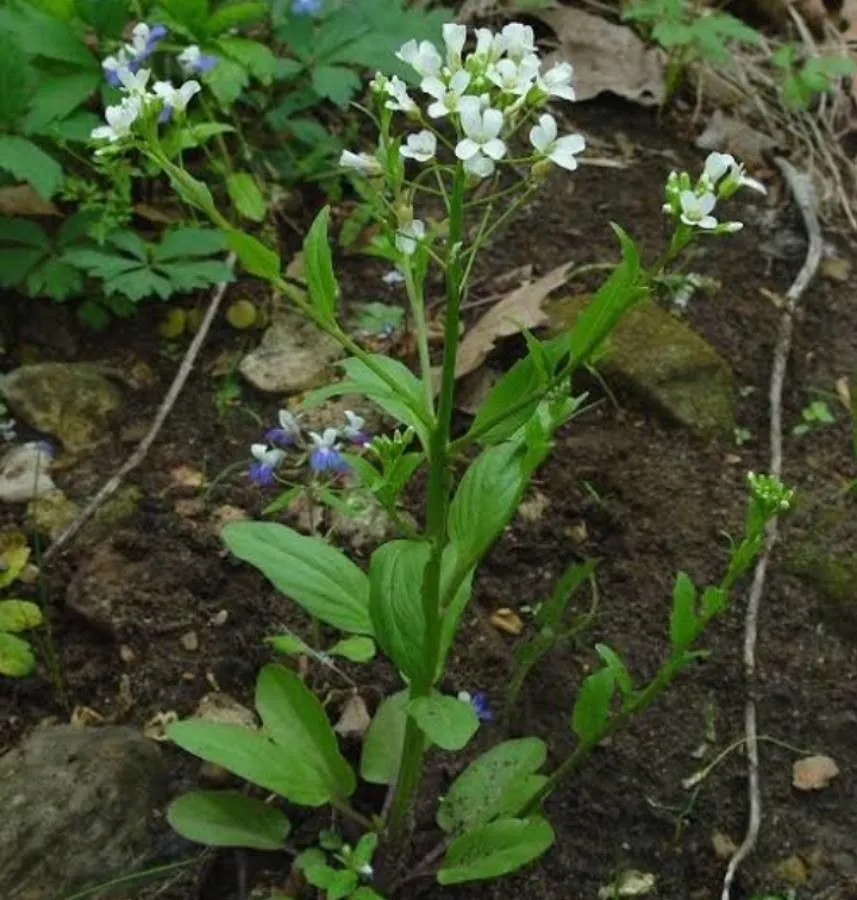
Author: (Schreb. ex Muhl.) Britton, Sterns & Poggenb.
Bibliography: Prelim. Cat.: 4 (1888)
Year: 1888
Status: accepted
Rank: species
Genus: Cardamine
Vegetable: False
Observations: C. & E. Canada to C. & E. U.S.A.
The Bulbous Bittercress, scientifically named Cardamine bulbosa, is a member of the Brassicaceae family and is native to central and eastern regions of both Canada and the United States. First described in 1888, with the authorship attributed to Schreb. ex Muhl. and Britton, Sterns & Poggenb., this plant species has captured the interest of botanists and plant enthusiasts alike.
Characterized by its distinct bulbous base, the Bulbous Bittercress is typically found in moist, shaded habitats such as wet meadows, stream banks, and forested wetlands. This perennial herbaceous plant often adds to the biodiversity of these ecosystems, supporting the intricate web of life that flourishes in such environments.
The leaves of the Bulbous Bittercress are typically compound and may exhibit a variety of shapes, with smooth edges that contribute to the plant’s delicate appearance. During its blooming period, the plant produces small, yet striking white flowers that enhance its aesthetic appeal and attract various pollinators. These flowers are arranged in a raceme, showcasing the plant’s reproductive structures effectively.
Propagated primarily by seeds, Cardamine bulbosa has adapted well to its native regions, demonstrating resilience in the face of varying environmental conditions. Its role in the local ecology extends beyond mere decoration; it participates actively in nutrient cycling and provides habitat and nourishment for an array of insect species.
Bulbous Bittercress is not only valued for its ecological contributions but also holds a place in the hearts of native plant gardens and restoration projects. As awareness of native plant conservation grows, species like Cardamine bulbosa become vital symbols of biodiversity and sustainability.
In summary, the Bulbous Bittercress is a noteworthy species within the Brassicaceae family that thrives in the moist, shaded areas of central and eastern Canada and the United States. Its unique morphology, ecological significance, and adaptability make it a fascinating subject of study and a cherished component of native flora.
Eng: bulbous bitter-cress, bulbous bittercress, spring cress, bulbous cress
Fra: cardamine bulbeuse
En: Bulbous bittercress, Bulbous Cress, Cuckoo-flower, Spring Cress, Spring-cress, Bulb bittercress, Bulbous bitter-cress
Fr: Cardamine bulbeuse
Taken Jul 20, 2019 by Brett Bissell someguy (cc-by-sa)
Taken Apr 18, 2022 by Taylor (cc-by-sa)
Taken May 16, 2019 by Leah Harrison (cc-by-sa)
Taken May 16, 2019 by Leah Harrison (cc-by-sa)
Taken Apr 18, 2022 by Taylor (cc-by-sa)
Taken Apr 18, 2022 by Taylor (cc-by-sa)
Taken May 19, 2021 by jake kristophel (cc-by-sa)
Taken May 16, 2019 by Leah Harrison (cc-by-sa)
Taken May 25, 2020 by Sam Biniecki (cc-by-sa)
Growth form>: Single Crown
Growth habit>: Forb/herb
Growth rate>: Rapid
Ph maximum: 6.8
Ph minimum: 5.0
Family: Myrtaceae Author: (F.Muell.) K.D.Hill & L.A.S.Johnson Bibliography: Telopea 6: 402 (1995) Year: 1995 Status:…
Family: Rubiaceae Author: Pierre ex A.Froehner Bibliography: Notizbl. Bot. Gart. Berlin-Dahlem 1: 237 (1897) Year:…
Family: Sapindaceae Author: Koidz. Bibliography: J. Coll. Sci. Imp. Univ. Tokyo 32(1): 38 (1911) Year:…
Family: Asteraceae Author: A.Gray Bibliography: Pacif. Railr. Rep.: 107 (1857) Year: 1857 Status: accepted Rank:…
Family: Fabaceae Author: Medik. Bibliography: Vorles. Churpfälz. Phys.-Ökon. Ges. 2: 398 (1787) Year: 1787 Status:…
Family: Aspleniaceae Author: (Cav.) Alston Bibliography: Bull. Misc. Inform. Kew 1932: 309 (1932) Year: 1932…